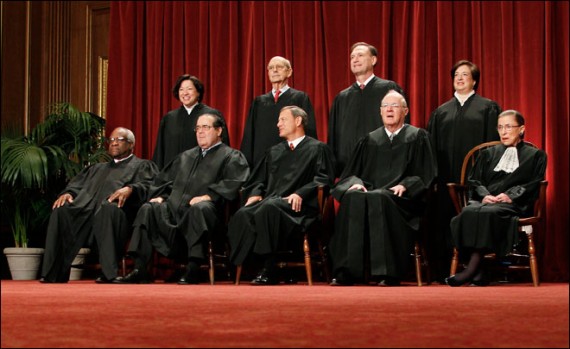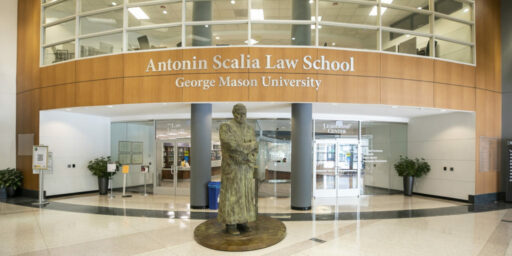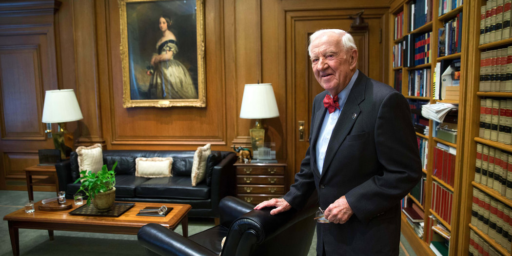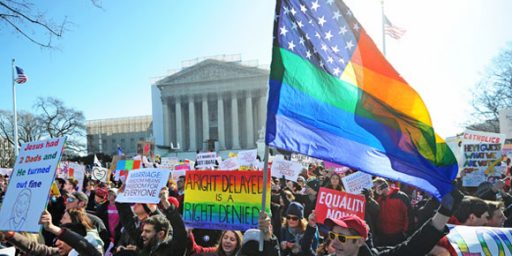Supreme Court Quietly Revises Opinions With Little Notice To The Public
The Supreme Court, subject to revision.
The New York Times’ Adam Liptak reports that the Supreme Court has been quietly making revisions to opinions after publication, with little actual notation that changes have actually been made:
WASHINGTON — The Supreme Court has been quietly revising its decisions years after they were issued, altering the law of the land without public notice. The revisions include “truly substantive changes in factual statements and legal reasoning,” said Richard J. Lazarus, a law professor at Harvard and the author of a new study examining the phenomenon.
The court can act quickly, as when Justice Antonin Scalia last month corrected an embarrassing error in a dissent in a case involving the Environmental Protection Agency.
But most changes are neither prompt nor publicized, and the court’s secretive editing process has led judges and law professors astray, causing them to rely on passages that were later scrubbed from the official record. The widening public access to online versions of the court’s decisions, some of which do not reflect the final wording, has made the longstanding problem more pronounced.
Unannounced changes have not reversed decisions outright, but they have withdrawn conclusions on significant points of law. They have also retreated from descriptions of common ground with other justices, as Justice Sandra Day O’Connor did in a major gay rights case.
The larger point, said Jeffrey L. Fisher, a law professor at Stanford, is that Supreme Court decisions are parsed by judges and scholars with exceptional care. “In Supreme Court opinions, every word matters,” he said. “When they’re changing the wording of opinions, they’re basically rewriting the law.”
Supreme Court opinions are often produced under intense time pressure because of the court’s self-imposed deadline, which generally calls for the announcement of decisions in all cases argued during the term before the justices leave for their summer break. In this term, 29 of the 70 cases argued since October remain to be decided in the next five weeks or so.
The court does warn readers that early versions of its decisions, available at the courthouse and on the court’s website, are works in progress. A small-print notice says that “this opinion is subject to formal revision before publication,” and it asks readers to notify the court of “any typographical or other formal errors.”
But aside from announcing the abstract proposition that revisions are possible, the court almost never notes when a change has been made, much less specifies what it was. And many changes do not seem merely typographical or formal.
If you look at the slip opinions that the Supreme Court issues on its decision days, or which are issued by Federal Courts nationwide, it does say that the opinion is subject to revision prior to publication in the appropriate official reporter. You often see the same thing on opinions issued by state courts that are destined for publication. In principle, of course, there’s nothing wrong with this. As noted above, these opinions are often produced on a compressed time schedule and can be quite lengthy depending on the nature of the case. Even with the Justices and several law clerks reviewing the drafts before they’re submitted, it’s inevitable that typographical errors and incorrect citations to previous cases will creep into the opinion somewhere. Making those revisions without announcing them doesn’t really raise much concern for me. As Liptak notes, though, many recent revisions have been far more substantive than merely cleaning up typographical and proofreading errors:
Last month, Justice Scalia made a misstep in a dissent in a case involving the E.P.A. Under the heading “Plus Ça Change: E.P.A.’s Continuing Quest for Cost-Benefit Authority,” he criticized the agency for seeking such authority in a 2001 case. But he got its position backward. Worse, he was the author of the majority opinion in the 2001 decision.
Law professors pointed out the mistake, and Justice Scalia quickly altered his opinion, revising the text and substituting a bland heading: “Our Precedent.”
Even more recently, Justice Elena Kagan this month corrected her dissent in Town of Greece v. Galloway, modifying a categorical assertion about the location of the first community of American Jews.
The court did not draw attention to the changes, but they did not go unnoticed. Other revisions have. A sentence in a 2003 concurrence from Justice O’Connor in a gay rights decision, Lawrence v. Texas, has been deleted from the official record. She had said Justice Scalia “apparently agrees” that a Texas law making gay sex a crime could not be reconciled with the court’s equal protection principles.
Lower court judges debated the statement, and law professors used it in teaching the case. The statement continues to appear in Internet archives like Findlaw and Cornell Law School’s Legal Information Institute.
But it has vanished from the official version published in 2006 and from the one available on Lexis, a legal database.
“They deliberately make it hard for anyone to determine when changes are made, although they could easily make that information public,” Professor Lazarus wrote in the study, which will be published in The Harvard Law Review.
In revisions to two 2009 opinions, on school searches and race-conscious hiring, Justice Ruth Bader Ginsburg added phrases to clarify and broaden the points she had made. The changes appear in Lexis, but the court’s website still features the original versions.
The court also corrects factual errors, including, in recent years, ones about who was president in 1799, which senator made a particular statement and whether a defendant was convicted or merely indicted.
While it doesn’t appear that these revisions have ever actually resulted in substantive changes in the holding of an opinion, or in the substance of the legal argument made in a majority, concurring, or minority opinion, they still clearly go beyond merely correcting typos and proofreading errors. The Scalia and Kagan cases, for example, involve the correction of rather obvious factual errors that somehow made it through the drafting phase. While that’s not necessarily objectionable, the fact that it was done with little notice does raise concerns. The O’Connor and Ginsburg case raise different questions. In both of those cases, the changes appear to make substantive changes in the arguments that both Justices made, and while they didn’t change the conclusions they reached, they were more than mere corrections of a typo.
The concerns that revisions like this make are two-fold. First, there’s the rather obvious fact that the opinions that the Supreme Court issues, including its concurrences and dissents often form the basis for arguments that attorneys make in future cases in courts throughout the country. There are, in some very real sense of the word, a part of the “law of the land.” The idea that they can be changed with little public notice is thus somewhat disturbing, and potentially embaressing for attorneys and clients who inadvertently relied upon a pre-revision copy of an opinion. In addition to being part of the law, though, these decision are also a part of history and there’s something very disturbing about the historical record being altered in this manner with no easy way to figure out that its happened. These are Supreme Court opinions after all, they ought to be treated with a little more seriousness than George Lucas treated the question of whether Han or Gredo shot first.
As Jonathan Adler notes, and as I stated above, it’s understandable and inevitable that mistakes will occur in Supreme Court opinions, and there’s nothing wrong with correcting those mistakes. When they do so, however, the Court ought to be more open about the changes that were made.
UPDATE (James Joyner): I wrote a longish post of my own on this before seeing that Doug had beat me to it. Since our takes are quite similar, I’ve decided to consolidate the discussion here.
First, when I saw the headline “Final Word on U.S. Law Isn’t: Supreme Court Keeps Editing,” I thought it was going to be a story about SCOTUS issuing rulings that countermand previous, even relatively recent, decisions. While problematic given that stare decisis is the bedrock of a common law system, it’s hardly a new phenomenon. Instead, Liptak is pointing us to something far more subtle and potentially more significant.
Second, as someone who writes a lot, I sympathize. I’ll frequently edit years-old blog posts to correct misspellings, formatting errors, broken links, and the like. But the ethic of the blogosphere is that one doesn’t change the substance of what one wrote without noting the correction prominently on the same page. As noted over the years, many news organizations follow a different practice, treating story pages as a placeholder for the current draft. Regardless, no one is relying on my blog posts—or even the reporting of the NYT or the AP—as the law of the land.
Third, it’s worth noting this point, which one has to read well into Liptak’s report to find:
After-the-fact editing is not a new phenomenon. “The current court did not begin this practice, which finds its origins in the court’s earliest days and has extended to all justices over the years, liberal and conservative, but the court today can take the steps to correct it,” Professor Lazarus said. “Easy to do, and long overdue.”
The court seems to have been even more freewheeling in the past. Chief Justice Roger B. Taney added approximately 18 pages to his 1857 majority opinion in the Dred Scott decision after it was announced.
There are indications in former justices’ papers that the court knows that its editing practices are open to question.
By making a “considerable number of corrections and editorial changes in the court’s opinions after their announcement and prior to their publication in the United States Reports,” a court official wrote to Chief Justice Warren E. Burger in 1984, “we actually operate a system that is completely at odds with general publishing practices.”
In an internal memorandum in 1981, Justice Harry A. Blackmun offered reasons that the court operated “on a strange and ‘reverse’ basis, where the professional editing is done after initial public release.” Once an opinion has garnered the five votes needed to have it speak for the court, he said, the author wants to issue it immediately to guard against defections and “get ‘on the scoreboard.’ ”
There are four generations of opinions, and only the last is said to be final. So-called bench opinions, in booklet form, are available at the court when decisions are announced. Slip opinions are posted on the court’s website soon after. They are followed by preliminary softcover prints and then by the only official versions, which are published in hardcover volumes called United States Reports. The official versions of opinions from 2008 were published in 2013.
This is interesting, indeed. I’ve been interested in the process going back to my first constitutional law class way back in 1986, took several more law-related classes at both the graduate and undergraduate level, taught undergraduate classes on the judicial process and con law, and have written probably hundreds of related blog posts over the years. This is the first I’ve heard of this phenomenon. I was, of course, aware that there were bench and slip opinions published before the official ones but miunderstood this to be an iterative release of a final written opinion; it never occurred to me that SCOTUS was releasing its opinions in rough draft form subject to substantive revision for another five years.
There are two exceptions to the general practice of quietly slipping changes into opinions. One happens only after the decisions are published in final form. The hardcover books sometimes contain a page of “errata.”
The court also issues an occasional order formally revising an opinion. The most recent notable example was in 2008, when the court learned that it had banned capital punishment for child rapists partly based on the faulty premise that no federal law allowed such executions. In denying a motion for rehearing, the court issued an order revising parts of the original decision to reflect the correct information.
But most changes can be found only by careful comparison or in the “change pages” that the court does not make public. Professor Lazarus obtained a year’s worth of the pages but was denied access to more. He said the court should consider posting them on its website.
“Of course the justices make mistakes,” he said. “And, of course, they can correct them. They just need to use a process that is more in keeping with the integrity and rigor of the process that produces the opinions in the first instance.”
That seems entirely reasonable to me. As noted earlier in Liptak’s piece, the precise wording of opinions matters because they provide a guide to the legal reasoning behind the ruling. While some language is considered mere “dicta,” having no precedential value, text is quite often cited years—sometimes decades or even centuries—later as part of the argument for a case having nothing whatsoever to do with the specific controversy that brought the conflicting parties to court. Given the proliferation of opinions in various highly credible online fora, it only behooves the Court to ensure that people know which versions are authoritative and what language has been revised over time and is no longer operative.
Finally, I wonder whether it’s true that there has been little harm here. Given how relatively rare and impactful Supreme Court decisions are, my bet is that the language from new opinions very quickly get incorporated into legal briefs and judicial opinions and that these then become secondary sources upon which future lawyers and judges rely. I know that in academia, a handful of quotes from, say, The Federalist Papers or Plato’s Republic or Alexis de Tocqueville’s Democracy in America get recirculated all the time by people who haven’t bothered to refer to the original sources. And, in a broader sense, various substantially off versions of movie quotes or lines from Mark Twain or William Shakespear and the like circulate in the popular culture and become “official” because they’ve gained a foothold. I’d wager that even Supreme Court clerks, who after all write the drafts of most opinions, do this all the time.







At the very least any changes to the original record, the original published decision, should be completely documented and annotated.
Was the 2003 O’Connor decision recently changed as the wording above implies? If it was, then the “revision before publication” doesn’t seem like it should apply. How far back can a current court go in simply rewriting the decisions of previous courts in this manner?
Their problem of course is that if such “corrections” make the public press, the image of the USSC as infalable is forever damaged.
Oops. That was already done.
Dred Scott et Al.
Never mind.
1. Nothing is more serious than Greedo shooting first.
2. I’m very happy if this revelation helps scrape away any of the naïveté that any grownups have about the Supreme Court. I don’t know if the Court ever truly lived up to it but the ideal that Justices put the law above politics and personal ideology has been a joke for a long, long time.
Mike
Between the initial slip opinion and when it’s published in the US reporter the updated versions are published where? Any idea?
Glenn Reynolds has an interesting suggestion for fixing this:
“We are not final because we are infallible, but we are infallible only because we are final.”
So… Not infallible or final.
One thing that I have noticed over the years is that these judges hardly ever appear in public on tv or give speeches. I think it would be nice if they came on some of the talk shows and discussed some of their cases. Even let viewers call in with their legal questions or if they are needing advice about some legal matter. It seems we never hardly hear from them. An appearance on the late night shows on the Sunday network news programs would not hurt anything.
I would like to ask their opinions about capital punishment and government condemnation of private property. Also their opinions about this legalizing marijuana.
@al-Ameda:
Indeed. Perhaps in a similar fashion to engineering documentation, where alterations with minor changes are indicated with rev numbers and more significant changes being part number changes.
@Tyrell: Questions I would have for a Supreme Court judge:
What is your opinion of the Booth conspirators trial? A military trial of civilians !
How about the JFK assassination ?
What would you have given Al Capone ?
What about the Lindbergh kidnapping trial ? That guy couldn’t have acted alone.
How about the O.J. trial fiasco? What would you have done differently if you had been the judge?
Have any ideas about the real identity of that Jack the Ripper murderer ?
Is there any case that you would have loved to been the judge ? What would your sentence have been for Dr. Lecter ?
These are the top judges. They are the experts.
“Justice is my province, and mine alone” (Pat Hingle as Judge Fenton in Clint Eastwood’s “Hang ‘Em High”)